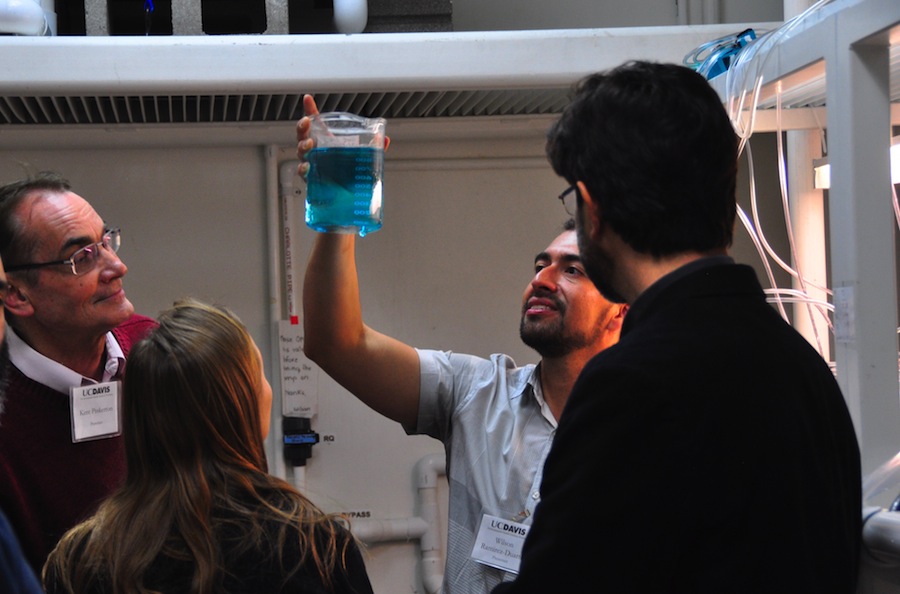
UC Davis Environmental Health Science Center hosts collaboration event to examine water safety, toxicity in Central Valley
The first ever UC Davis Environmental Health Science (EHS) Academy Day on March 21 brought together multi-disciplinary researchers and community organizations to better address and discuss concerns of environmental health impacts, specifically those centered around water safety and contamination issues in the Central Valley.
In California, about 20 percent of all groundwater is contaminated, impacting safe drinking water, as well as water for agriculture and recreational purposes. Contamination can come from pesticides, toxic metals, chemicals in personal care products or a change in climate.
There are a variety of human health issues prevalent in the Central Valley including infant death syndrome, blue baby syndrome, a syndrome associated with nitrates from drinking water decreasing the body’s capacity to carry oxygen, developmental cancer and immunological problems. However, they have not been scientifically proven to correlate with exposure to environmental risks.
“People don’t know how to decide if their water is safe to drink, and the lack of information can cause fear and concern that feeds the rumor mill on health impacts,” said Ryan Jensen, a community water solutions manager at the Community Water Center (CWC).
Attendants of the event included researchers with pilot projects at the center to community stakeholders and outreach organizations such as CWC and the Environmental Justice Coalition for Water.
The goal of EHS Academy Day was to bring together researchers in the field of environmental health and community outreach members to create an open dialogue about concerns specific to Sacramento and the San Joaquin Valley. In addition, all members were invited to a field trip to Vet Med Sciences 3B to see the fish facility that supplies models for research about impacts of water contamination on health.
“The questions we want to pose include: how can researchers engage with communities and make it culturally relevant, what’s the public health impact of certain chemicals that cause latent health effects and how do scientists go about proving or associating certain chemicals with human health impacts,” said Jonathan London, an associate professor of human ecology and community and regional development at UC Davis.
Community members were able to voice their concerns about the lack of access to safe drinking water for rural, farming and underserved populations.
Researchers at the Environmental Health Science Center (EHSC) presented the history and importance of using fish model systems to study environmental health.
Studying adverse effects of contaminants in aquatic environments and fish models in the Sacramento River and San Francisco Estuary can be applied to humans as well because of our exposure to the same water.
After an experiment observing the embryos of fish placed in specific sites along the San Francisco Estuary, concerning findings suggested something in the water is inhibiting proper growth and development of the fish. Genetic and hormonal factors were affected, as some fish had a lack of body development in embryos. In one case, immature eggs were found in testes of male fish.
Academy Day presented the science behind pilot projects as well as generated questions for an environmental health scientist. The aim was to get individuals thinking about how scientists may engage in community related issues and how community issues can generate questions about science and policy.
Environmental health is associated with public health, just more broadly defined. It is associated with how the environment influences human health and disease. Humans can be exposed to risk factors in their home, community and workplaces. Examples include air pollution, chemicals from pesticides and inadequate water and poor sanitation.
“Our mission is to promote and protect the wellbeing of all species and their environments,” said Swee Teh, the director of the Aquatic Health Program and an adjunct professor in the UC Davis Department of Anatomy, Physiology and Cell Biology.
Teh highlighted important ongoing projects including researching natural toxic algal blooms in the water as well as the impact of plastic debris infiltration of aquatic habits globally.
“The first toxic algae sighting was in 1999, and has become increasing in size and frequency in Delta and Bay region over the years,” Teh said.
These sites can shift due to water level and climate, especially cycles in drought and rain. Factors that contribute to toxic algae include water level and temperature. The study of plastic debris infiltration on aquatic habitats globally is significant because various plastics are ingested by hundreds of species.
“Large plastics cause strangulation of aquatic organisms,” Teh said. “Micro-plastics, plastic chemicals, are toxic in aquatic life and can affect development and behavior.”
The ingestion of large plastics can cause a bird or fish to think it is full. Since plastic doesn’t degrade easily and stays in the stomach, the animal dies of starvation.
Academy Day opened the doors for communication between researchers and community outreach groups. In addition, the researchers were able to hear the needs and concerns within the environmental health community.
“Notice that many questions generated from different groups can be applied to short term and long term time scale,” London said. “For example, the same issue such as pesticides association with human health may be immediate for scientists but long term for policy.”
Groups such as the CWC perform community outreach, such as community meetings, encouraging people to participate in policy in Sacramento, and bringing people to communities impacted from these factors, specifically those lacking safe and affordable drinking water.
“We provide state-wide advocacy to insure that everyone has basic access to safe water because often decision makers are not responsible to the needs of communities like farmers and low income families,” Jensen said.
Written by Shivani Kamal — science@theaggie.org



